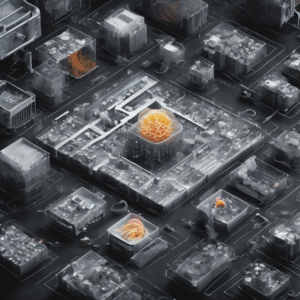
A Small Chinese Village at the Center of the US-China AI War 🌏🤖
In the vast tapestry of China’s technological ambitions, a tiny village called Yuzhong stands like a needle in a haystack, symbolizing a war that rages far beyond its borders. This village, with its humble brick lanes and rice paddies, has suddenly found itself at the epicenter of the escalating battle for artificial intelligence supremacy between the United States and China. How did a place with fewer inhabitants than a small town in Arkansas become so pivotal in such a formidable geopolitical chess game? ♟️
Perhaps it’s the irony of the situation—a village advancing the future while its residents often cling to age-old traditions, as if caught in a romantic time warp. In striking antithesis, Yuzhong’s picturesque rice fields contrast sharply with the towering ambitions of AI development that loom overhead. This juxtaposition of rural simplicity and technological revolution paints a vivid picture of the interplay between global forces and local realities.
The Rise of Yuzhong: From Tradition to Technology
The pivotal event that catapulted Yuzhong into the global arena was a government initiative aimed at enhancing agricultural productivity through AI. As if nature itself conspired with bureaucratic ambition, the village became a testing ground for advanced technologies, including drone agriculture and predictive analytics for crop yields. Farmers here now employ sophisticated algorithms to monitor soil conditions, which simultaneously whispers tales of centuries-old farming to the hum of artificial intelligence—a true digital yin and yang.
This transformation has not only revitalized the local economy but has also positioned Yuzhong as a microcosm of China’s broader strategic aims. By harnessing AI to boost food security, China aims to establish its dominance in both technology and agriculture, much like a chess master guarding critical pieces on the board. But can a few lush fields effectively counterbalance the economic might of the US? 💹
The Economic Implications Looming Large
As the US ramps up its competition for AI superiority through investments and legislation, Yuzhong’s small-scale triumphs echo in the corridors of power. The village symbolizes larger trends, highlighting a shifting landscape where rural innovation is perceived as a key driver of national strength. Yet, the irony lies in how rural areas—often viewed as laggards in technological progress—are now seen as anchors of resilience in a digital economy.
– China’s AI agenda aims to be a $150 billion industry by 2030.
– 70% of AI applications are expected to transform farming by implementing advanced analytics.
– Yuzhong’s agriculture sector has seen a 30% increase in yield due to AI integration.
However, beneath this veneer of progress, one must question: is this truly sustainable? While Yuzhong flourishes, other villages may face the brunt of neglect, highlighting disparities between urban tech hubs and rural tech experimentations—a lopsided tale reminiscent of past industrial revolutions.
Life Beyond the Algorithms
Interestingly, amid the coding and computations, local farmers remain deeply human. They share tales of working with drones and algorithms that buzz by like dragonflies—a metaphor for the balance they seek between modernity and tradition. Their lives are intricately woven with the land, every decision steeped in inherited wisdom passed down through generations. One can’t help but feel that this human element injects a necessary soul into an otherwise cold, calculating world of AI.
Villagers describe their newfound tools with awe, as though they’ve befriended magic rather than mere machines. “It’s like having a second brain,” one farmer explains, as he gazes at his crop data on a smartphone. This is not just technology; it’s a lifeline that connects ancient agricultural practices to futuristic methodologies, bridging history with a digital future that feels like a science fiction novel realized.
Looking Ahead: What’s the Future for Yuzhong?
As Yuzhong continues to thrive under the spotlight, one must ponder the broader implications of its transformation. Will the village become a model for rural empowerment across China and, indeed, the world? Or will it fade back into obscurity once the limelight shifts? Time will tell, but the human narratives embedded in this story reveal profound truths about the interconnectedness of our global society.
In the end, as the winds of change blow through the rice paddies of Yuzhong, they carry with them both hope and uncertainty. This humble village, caught between past and future, stands as a beacon of what is possible in an era marked by both daunting challenges and monumental opportunities. Perhaps one day, as the sun sets over the fields, it will illuminate the way forward—a path where humanity and technology coexist harmoniously, like two sides of the same coin. 🌅






